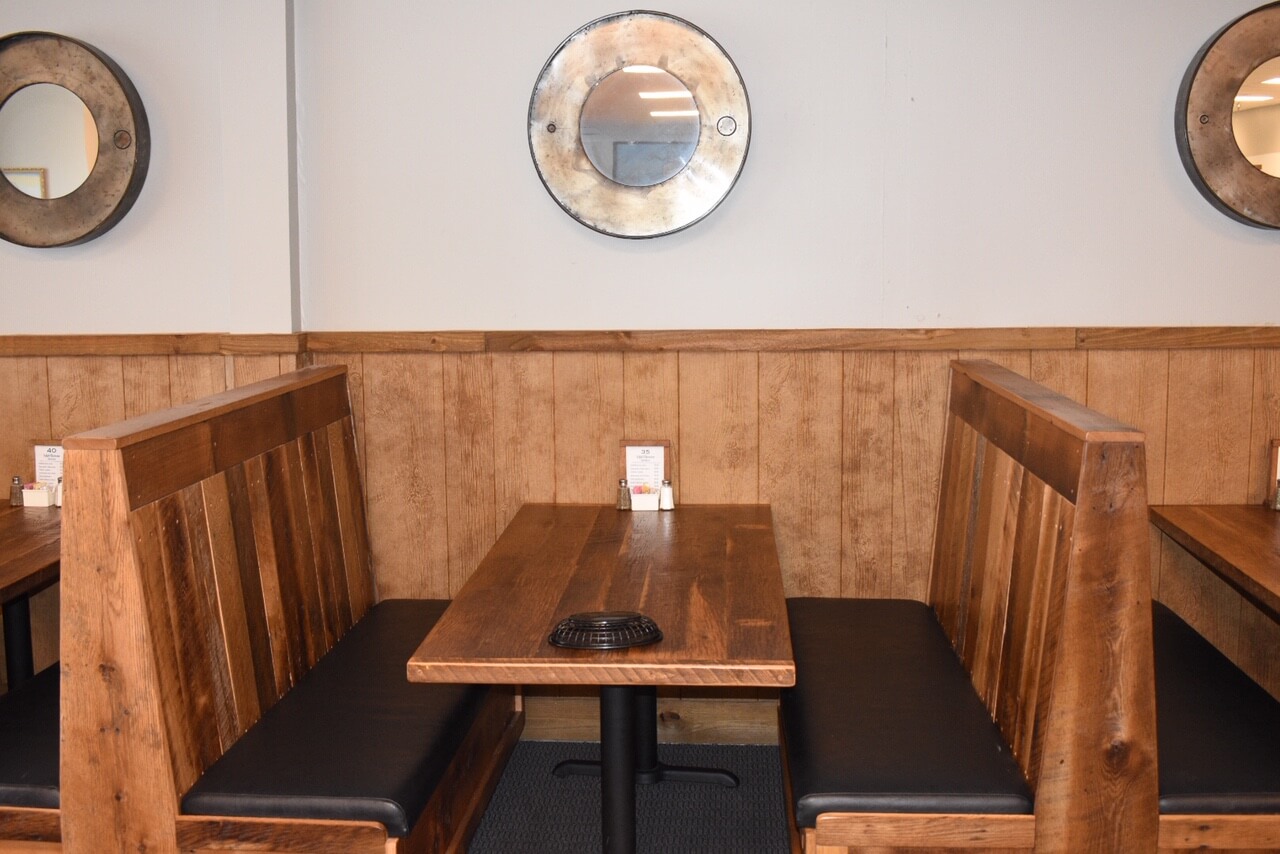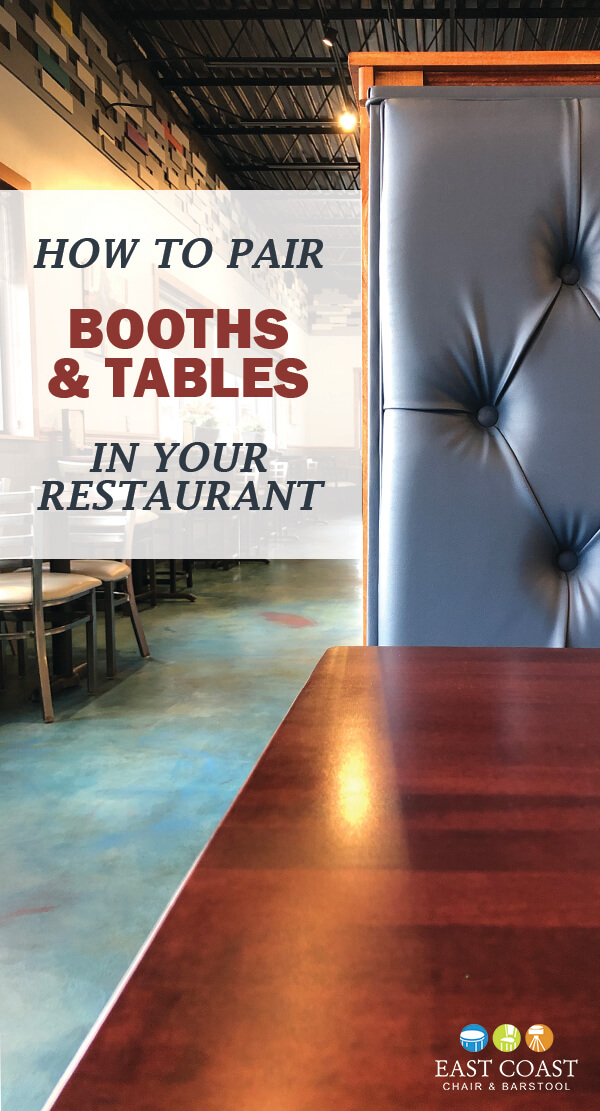Selecting booths and tables for your restaurant can be a big decision. They need to look right together, but they also need to function well. Choosing the wrong pairing can result in an uncomfortable dining experience for the guest, and lost revenue for you!
So we’re breaking down some factors for you to consider, from size to design, to help you pair the right booths with the right tables.
Dimensions
The first thing to consider when selecting booths and tables is their respective sizes. The dimensions of your restaurant will, to some extent, dictate the size of the tables and booths that you can install. Use the following size guidelines as you determine how many and what size tables and booths you’ll need.
Length
You’ll want to make sure that your table length is approximately the same as your booth length. There are a variety of “standard” booth lengths, from a 24” single-seater all the way up to 60” for 3 or even 4 people per side. If you were to pair a 36” table with a 48” booth, you’d have a foot of extra booth space making your table look undersized. So make sure to match your booth and table length.
Depth
Since booths aren’t pulled under the table like a chair, it’s important to consider your table width and booth depth. You want to make sure that guests can reach their food, but aren’t knocking their knees together under the booth.
If you have a standard 30” table, you’ll want to leave about 72” between each booth top cap. The top cap is the piece of the booth that “caps” the back of the seat at the top. For a more narrow 24” table, 66” between each top cap will be enough. Make sure you have enough room for at least 16” between the seat back and the edge of the table. You don’t want guests to feel wedged between the booth and the table!
Height
You will also need to consider seat height and back height. A good rule of thumb for seat height is to allow about 12” between the seat and the tabletop. So a booth with a seat 18” off the ground would go well with a 30” tall table.
Finally, there is the back height. The back of the booth doesn’t affect functionality, but it does affect the flow of your space. If you have a small restaurant, a tall seat back can make it feel smaller and more enclosed. But if your restaurant is very large and you want it to feel cozier, tall seat backs might be a good option.
Style
Once you have a basic idea of dimensions, you can start considering the style of your tables and booths. They should work together, but they also need to fit into your restaurant as a whole.
Booths come in a variety of sizes and designs. The most common is the single or double booth. A single is just that — one booth. The back is flat and can be placed against a wall or at the end of a row of booths. The double booth is two booth seats that share the same back. These booths are designed to work with a rectangular table, which provides a lot of options.
There are also ½ circle or ¾ circle booths. These can often seat more people than the single or double booth. They’ll also require a larger table since the diners will be sitting on three sides instead of two. To figure out the best table size for these round or square booths, first measure the width of the open space in the middle. You want your table to slightly overhang the bench seat. So if the open space is 44”, a 48” table would be perfect.
Banquette booths are usually long, built-in benches that go along one wall. They’ll be faced by a table and a chair on the other side. These can be a great space saver, and don’t enclose your seating the way a traditional booth does. But keep in mind that instead of only matching a table to your booth, you’ll have to match a table and chair to your booth.
Do you want to open up your space and create a flow? Banquettes are great for this, since they effectively remove the barrier between tables. A banquette provides a lighter booth option that can be paired with a wide variety of tables.
On the other hand, a heavy, dark booth will encourage guests to hunker down and get intimate. Don’t let your table get overpowered. A substantial booth requires a substantial table to balance it out.
Fabric and Finishes
Your table and booth finishes will create a lot of visual interest in your space. So it’s important to get them right.
But they don’t have to match. In fact, a matchy-matchy set of booths and tables may look a little dated. That can be great if you’re going for a retro look. A brightly colored vinyl booth with a matching laminate table would look right at home in a 50s-style diner.
For a more modern look, consider adding some contrast. A booth in a bright color, like turquoise or orange, contrasted with a rustic wood table will look current and casual. Or you could pair a light ivory booth with a rich mahogany table for an upscale look.
You can also add multiple colors to your booth, or a splashy fabric. Keep fabric patterns on the larger side to keep them from looking too busy.
You can even use two entirely different colored booths in different parts of your restaurant. For example, you could have a golden yellow banquette on one side of the space, and a row of deep red double booths on the other. But when the booths are eye-catching, keep the tables simple. You could choose a warm wood tone that works well with both booth colors to help tie the space together. Or pick a neutral granite tabletop that has flecks of each color in the stone variations.
For banquettes, you can get a matching set of booths and chairs to keep the look consistent. Or use the chair as an opportunity to pull in something new. A brown leather tufted banquette bench, reclaimed wood table, and vibrant red industrial chair will create a unique modern space.
To tie your booths and tables together, look for a single element to repeat on both. For example, you could use gold or bronze accents on both your booth and table to make them appear more cohesive.
Keep wear and tear in mind. A family-friendly restaurant may want to consider vinyl or an unupholstered booth, rather than one finished in a costly fabric.
Conclusion
Pairing booths and tables requires some planning ahead and homing in on your restaurant style. Once you’ve figured out layout and furniture size, you can start to consider design and finishes.
Remember that if you can’t find the perfect booth for your restaurant, there’s always the option to have something custom built.







